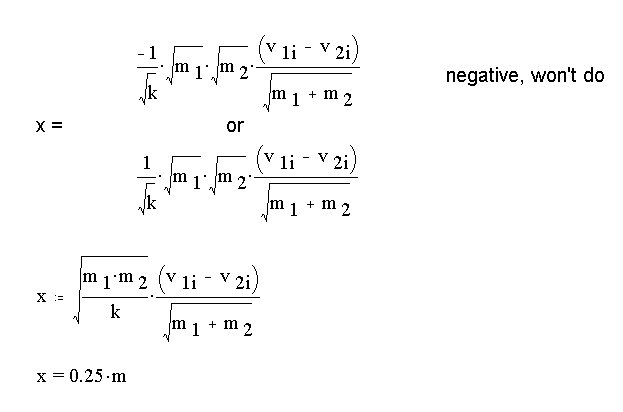
| Last revised 1999/11/02 |






67.
 We are given that vB2 is perpendicular to
vB1 and that
vB2 / vB1 = 1/2 .
We must find the direction that A moves after the collision. For any
collision problem, we can use momentum conservation:
We are given that vB2 is perpendicular to
vB1 and that
vB2 / vB1 = 1/2 .
We must find the direction that A moves after the collision. For any
collision problem, we can use momentum conservation:
| horizontal: | MBvB1 = mA vA2 cos(theta) |
| vertical: | 0 = MB vB2 - MA vA2 sin(theta) |
MB vB2 = MA vA2 sin(theta)
We can divide the second equation by the first to get
tan(theta) = vB2 / vB1 = 1/2
theta = 27o
We cannot, however, determine the speed of A , because we
have not been given values for the masses.
68.
The figure for problem 67 applies to this problem as well. In this
case, MB is the mass of 1 nucleon, call it
M, and MA is then 2M. We are
supposed to find the fraction of the initial kinetic energy carried
away by the deuteron, in other words to evaluate f where
f = (1/2)(2 M) vA22 / [(1/2) M vB12.
We can again use momentum conservation, and this time energy conservation as well. After masses and factors of 1/2 are cancelled, the equations read
vB1 = 2 vA2 cos(theta)
0 = vB2 - 2 vA2 sin(theta)
vB12
= vB22 + 2 vA22
Moving the first term in the second equation to the left-hand side, then squaring each of the first two equations and adding, we can eliminate theta, getting
vB22 + vB12 = 4 vA22
We can use this equation to eliminate vB2 from the third of the original equations, yielding
vB12 = 3 vA22
Substituting this result into the definition of f gives
f = 2/3
as required.
| We are given | alpha= 4 a t3 - 3 b t2 |
| Integrating once gives | omega = omega0 + a t4 - b t3 |
| and integrating again gives | theta = theta0 + omega0 t + (1/5) a t5 - (1/4) t 4 |





44.
We are given that the period T of the crab pulsar is given by
|
T = T0 + T1 T0 = 0.033 s T1 = 1.26 x 10 -5 s/yr = 3.99 x 10 -13 [using 1 yr = 3.16 x 107 s]. | [Eq. 1] |
|
We want to get We need the definition of omega in terms of the period, and the expression for the time-dependence of omega under constant angular acceleration:
| |
| omega = 2 pi / T | [Eq. 2] |
| omega = omega0 + alpha t | [Eq. 3] |
|
Using Eqs. 1 and 2 we have
omega = 2 pi / [ T0 + T1 t]
and using the binomial expansion, so that
| |
| omega0 = 2 pi / T0 = 190/s | |
| alpha = - (2 pi T1) / T02 = -2.30 x 10 -9 / sec2 | [Answer to (a)]
|
|
To get the time when omega = 0 we use eq. 3 0 = omega = omega0 + alpha t t = - omega0 / alpha | |
| = 8.28 x 1010 sec = 2.62 x 103 yr3 |
[Answer to (b)]
|
We can substitute into the same equation to find what the value of
omega was when the pulsar was formed in 1054 AD (943 years ago). The
result is
|
| omega = 259 / s | [Answer to (c)] |
59.
We need to know something about the kinetic energy of a flywheel and
about the relation between energy and power when the power is constant
(or we are using average power). The relations are
Kinetic Energy: KE = (1/2) I omega2
Moment of Inertia of a wheel: I = (1/2) M R2
Power: P = dE/dt so that E = E0 + P t
{P constant)
We have been given
omega = 200 pi / s
M = 500 kg
R = 1.0 m
P = - 8.0 kW
Substituting for the moment of inertia in the formula for the kinetic energy gives
KE = (1/4) M R2 omega2 = 49 x 106 j.
The solving E = KE + P t gives
t = - KE/P = 6.1 x 103 s = 100 min
Links to image files used in these solutions:10-27, 27a, 27b, 27c, 27d;10-55, 55a, 55b, 55c; 10-67 and 10-68; 11-19, 19a, 19b, 19c, 19d, 19e. |